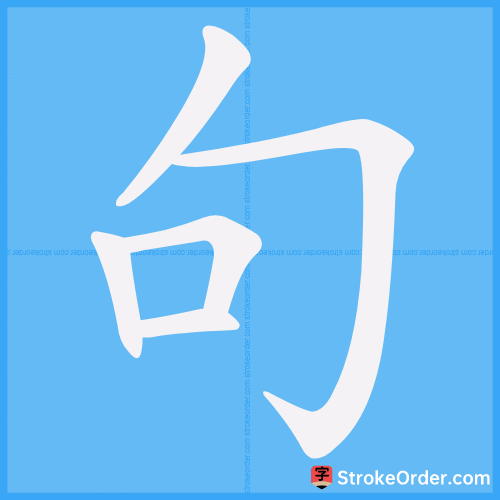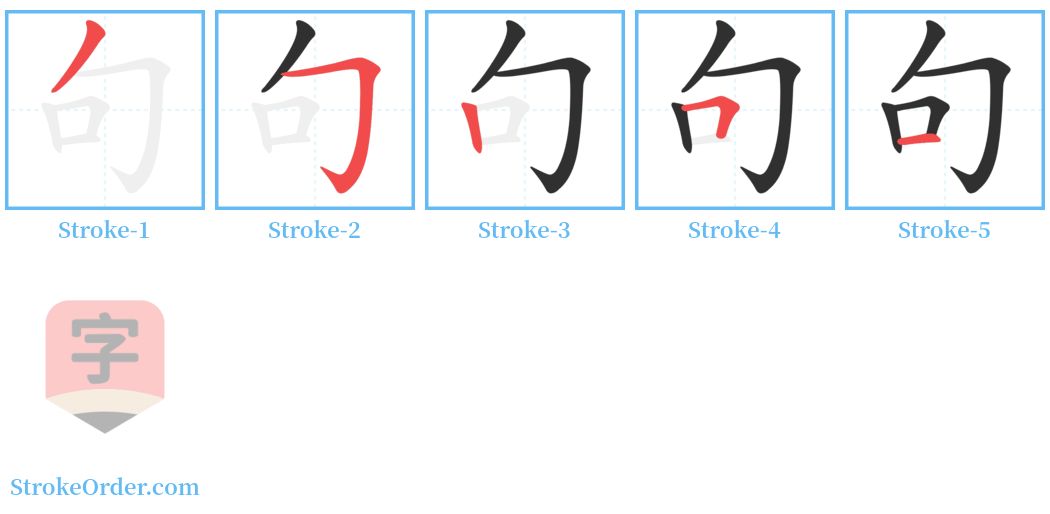句 Stroke Order
Animated Stroke Order of 句

Stroke Order Diagrams for 句

Step-by-Step Handwriting Guide for 句

Learn to Write Chinese Characters with Video Tutorials
Watch the video of writing the Chinese character "句", learn the correct stroke order (笔顺) of the character "句", and master the standard way of writing the character "句".
Free Printable Handwriting Practice with Stroke Order: 句
Printable Writing Practice Worksheet of "句" in Portrait Orientation (Tian Zi Ge)

Printable Writing Practice Worksheet of "句" in Landscape Orientation (Tian Zi Ge)

Information of 句
Pinyin
jù、 gōu
Radical
口
Strokes
5 strokes
Usage
★★★★★
Definition
(a measure word, for sentences or lines of verse) / sentence
句 [jù]
名词
1. A complete expression formed by words: 句子 (sentence), 句法 (sentence structure).
2. In ancient times, a place of pause in literary phrases was referred to as a "句" or "读".
3. A measure word used for language: 三句话不离本行 (Three sentences do not stray from the subject).
句 [jù]
名词
1. (Ideogram. The small seal script, composed of the element for mouth and the element for twist, resembling intertwined strands) The original meaning: to bend.
2. Sentences; poetic phrases ([En.] sentence).
3. During the Han Dynasty, a ceremonial practice where the lowest-ranking scholar among nine guests relays a message upward, in contrast with "胪" ([En.] message sent from bottom to top in a ceremony).
量词
1. Used for measuring language.
2. Used for measuring time, indicating points in time, equivalent to "点"; when indicating time intervals, equivalent to "个" (hour) ([En.] o'clock).
3. Refer to gōu.
高句
古国名,即“高丽”。 ([En.] An ancient nation name, namely "Goryeo.")
句 [gōu]
动词
1. Original meaning: to bend.
2. When plants emerge from the soil, the bent ones are called "句", and the straight ones are called "萌".
3. To strike out ([En.] strike).
4. To examine ([En.] examine).
5. To catch or seize ([En.] catch).
6. To seduce or entangle ([En.] seduce).
7. To delineate ([En.] delineate).
如果 —表示假设 ([En.] if).
句 [gōu]
名词
1. Refers to the tender bud of newly sprouted plants ([En.] tender bud).
2. A hook; later written as "钩" ([En.] hook).
3. An ancient term for the shorter leg adjacent to the right angle in a right triangle ([En.] the shorter leg of a right triangle).
4. Used as a personal name character.
5. Refer to jù.
Examples:
句把 (a couple of sentences, referring to very few words); 两句诗 (two lines of poetry).
【引】
1. "句" refers to "局", meaning a divided space for expressions.
2. Reference from historical texts.
3. "句" as in written lines in poetry or prose.
4. Various examples from classical Chinese literature showing the term's application.
(*Refer to the traditional dictionary explanation for additional context)
Input Method for 句
Pinyin
ju4
Wubi
qkd
Cangjie
pr
Zhengma
ryj
Four Corner
27620
Unicode
U+53e5
Same Pronunciation Characters